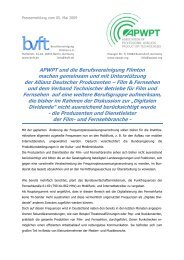<strong>Digital</strong> <strong>Dividend</strong>: <strong>Insights</strong> <strong>for</strong> <strong>spectrum</strong> <strong>decisions</strong>transmissions had to be planned “around” analogue transmissions, their frequency plan (i.e. the set offrequencies used by every single transmitter) could only be a transitory plan and not optimum onceanalogue transmissions have been switched-off. 14 Reaching maximum digital coverage and makingavailable additional digital transmissions will there<strong>for</strong>e require the transition of digital transmissions to anew, optimized frequency plan, often called target frequency plan. This transition is normally effected atthe same time as analogue switch-off, hence the name of digital switchover (DSO) to designate thesimultaneous operation of switch-off and frequency changeover.From a <strong>spectrum</strong> management point of view, DSO there<strong>for</strong>e appears as a process through which thefrequency plan <strong>for</strong> broadcasting services is gradually modified from a transitory frequency plan(accommodating digital transmissions together with analogue ones) to a target frequency plan (optimized<strong>for</strong> digital transmissions).This process is illustrated by Figure 3-1. DSO starts with the first switch-off of an analogue transmission,which can only occur at a date D1 when digital TV coverage deployment has reached a sufficientpercentage P1 of the population, which should be close enough to that achieved in analogue <strong>for</strong>m. At adate D2 corresponding to the end of the DSO, a higher percentage P2 of the population is covered bydigital TV, all analogue transmissions have been switched-off and all digital transmissions moved to thetarget frequency plan. Between these two dates, the digital dividend <strong>for</strong> broadcasting has graduallymaterialized into additional coverage <strong>for</strong> previously existing digital services and additional digital services(such as additional multiplexes). During the process, the transitory frequency plan and the targetfrequency plan coexist in adjacent areas, which may require intermediate frequency changes in order tocontrol interference between such areas.Figure 3-1: The digital switchover process from a <strong>spectrum</strong> viewpointAccessVisitednetworkAnalogue TV<strong>Digital</strong> Switch-OverP2% populationP1% population<strong>Digital</strong> dividend<strong>for</strong> mobileDate 1HostnetworkDate 2Transitory frequency planTarget frequency PlanSource: Authors14Planning criteria <strong>for</strong> various methods of providing digital terrestrial television services in the VHF/UHF band are given inRecommendation <strong>ITU</strong>-R BT.1368-9. www.itu.int/rec/R-REC-BT.1368/en10
<strong>Digital</strong> <strong>Dividend</strong>: <strong>Insights</strong> <strong>for</strong> <strong>spectrum</strong> <strong>decisions</strong>Given the magnitude of these two operations, the political, cultural and social importance of theterrestrial television service and their potentially disruptive effect on this service, DSO is a national issue,which needs to involve:APIs and service enablers are used to provide the user with a more varied, friendlier communicationenvironment accessible with various types of fixed and mobile terminals anywhere where the network isavailable. Service enablers are generic components that make it easier to create services and applications:• government and/or legislative backing,• advance planning and coordination of all activities,• communication to the public,• technical assistance to the population,• financial assistance to the population, which may cover the purchase of digital receivers or, incase of loss of terrestrial service, the purchase of alternative equipment, such as satellitereceive equipment.As part of the preparation of DSO, a clearly established target plan is a pre-requisite to avoid disruptivedomino effects in case of changes.If the target plan of a country is not agreed with its neighbours, this plan should there<strong>for</strong>e be negotiatedwith them be<strong>for</strong>e DSO can be envisaged. For countries which are contracting members of the GE06Agreement, the GE06 plan, as adopted by RRC-06, was designed to provide this target plan. The <strong>decisions</strong>of WRC-07 and WRC-12 on the allocation of the digital dividend, which are discussed in the followingsection, have however, somewhat complicated the situation.3.4 International framework <strong>for</strong> the digital dividend allocationAt international level, <strong>spectrum</strong> is managed by the Radiocommunication Sector of <strong>ITU</strong> (<strong>ITU</strong>-R). Its missionis to ensure the rational, equitable, efficient and economical use of the radio-frequency <strong>spectrum</strong> by allradiocommunication services, including those using satellite orbits, and to carry out studies and approveRecommendations on radiocommunication matters.In implementing this mission, <strong>ITU</strong>-R aims at creating the conditions <strong>for</strong> harmonized development andefficient operation of existing and new radiocommunication systems, taking due account of all partiesconcerned. This is ensured by the following activities:• timely adoption and/or update of the international regulations on the use of <strong>spectrum</strong>: theRadio Regulations and the Regional Agreements,• standardization of radiocommunication equipment by the adoption of ´Recommendations´intended to assure the necessary per<strong>for</strong>mance and quality in operating radiocommunicationsystems,• in<strong>for</strong>mation and assistance to <strong>ITU</strong> membership on the most efficient use of <strong>spectrum</strong>.Frequency allocations are decided at the international level by <strong>ITU</strong> World RadiocommunicationConferences (WRC). These conferences are held every three to four years and update the <strong>ITU</strong> RadioRegulations (RR), an international treaty which has binding effect on <strong>ITU</strong> Member States.In each frequency band, the RR specifies which radiocommunication services may be used: in regulatoryterms, this frequency band is allocated to these services. Such services may relate to terrestrialradiocommunications (e.g. fixed, mobile, broadcasting, radiolocation, radionavigation, earth-exploration)or to satellite communications (e.g. fixed-satellite, mobile-satellite or broadcasting-satellite). Theseallocations support applications as varied as radio relays, radars, satellite television, FM radio, CB, newsgathering, mobile telephony, WiFi, emergency communications, meteorology or satellite imaging orpositioning and earth resource monitoring, which have taken an increasing importance in our day-to-daylife in the past twenty years.11






